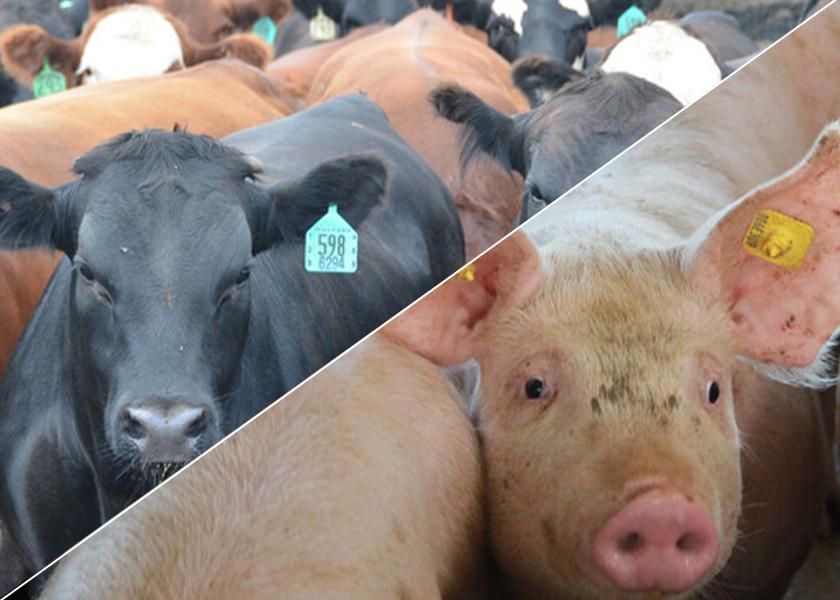Livestock Analysis | December 7, 2021

Price action: February lean hog futures plunged $1.675 to $76.55, the contract’s lowest closing price since $74.325 on Oct. 27. December futures rose 2.5 cents to $72.075.
Fundamental analysis: Hog futures extended yesterday’s nosedive as poor cash fundamentals and bearish market psychology continued to burden market. The CME lean hog index rose for the third day in the past four, to $70.78, but traders appear to be unconvinced the market has put in a bottom. Wholesale pork rose modestly yesterday and may climb further this week as grocers complete ham purchases for Christmas over the next 10 days. Still, traders apparently anticipate a drop in the ham market once those purchases are completed. The industry’s tradition of pushing weekly hog slaughter to an annual high next week may also be weighing upon prices.
While December futures’ decline yesterday suggested the industry has greatly reduced its expectations for short-term cash strength, today’s relative firmness implies traders still expect modest gains over the next week. The preliminary reading for the next lean hog Index edged up 16 cents to $70.94.
Also, the industry may be growing more pessimistic over pork demand in 2022, since early winter hog supplies are expected to run 3.0% to 4.0% below year-ago rates and the fall pig crop implies spring kills will fall 6.0% year-over-year. We think the implicit price forecasts built into hog futures are extremely conservative, especially considering the hog index moved above $95.00 last March and didn’t fall back below that level until mid-September.
Technical analysis: February futures’ 6.1% tumble so far this week has removed a large amount of premium from the market and given bearish traders the technical advantage. Initial support is likely at today’s low of $76.125, with additional support likely to emerge at the Sept. 16 low of $74.625, then at the Oct. 28 low of $74.05. A drop below that level would have bears targeting $70.00.
Look for initial resistance at yesterday’s low of $78.175, then at the 40-day moving average near $79.90 and the psychologically important $80.00 level. A close above that point would then have bulls again targeting the Nov. 26 high of $84.675.
What to do: Get current with feed advice.
Hedgers: You currently have all risk in the cash market.
Feed needs: You should have all soybean meal needs covered in the cash market through December. You are still hand-to-mouth on corn-for-feed needs.
Price action: February live cattle futures fell 42.5 cents to $139.225, near the middle of the day’s range. The most-active contract is up $1.325 since the end of November. January feeder cattle fell 22.5 cents to $165.025.
Fundamental analysis: Live cattle futures were pressured by slumping wholesale beef prices and ideas the recent strength in the cash market is losing momentum. Cash trade has yet to establish a firm tone so far this week, but prices are expected to hold around steady with last week’s multi-year highs amid limited supplies of market-ready animals. Last week’s average live steer price rose $2.27 to $140.44, the ninth consecutive weekly gain and the highest since at least June 2017.
Boxed beef values slipped again today, further illustrating retailers’ struggles to move increasingly pricey cuts. Choice cutout values early today fell $2.93 to $269.60, the lowest daily average since late July. Movement by midday was 73 loads, USDA reported. Wholesale beef prices are expected to remain under pressure through the end of the year.
Packers stepped up kills slightly so far this week, slaughtering an estimated 245,000 head through today, up 2,000 from the same period last week and up 10,000 from the comparable period in 2020, USDA data showed. Cattle slaughter so far this year is up about 2.9% from the same period last year.
Technical analysis: Live cattle bulls have a solid near-term technical advantage with a two-month uptrend on the daily bar chart. Upside price objectives include closing February futures above solid resistance at the contract high of $141.85. For bears, downside objectives include closing February below solid support at $135.00. First resistance is seen at $140.375, then $141.00. First support is seen at yesterday’s low of $138.45, then at last week’s low of $137.35.
What to do: Get current with feed advice. Short-term protective hedges may be needed if this week’s lows are violated.
Hedgers: Carry all risk in the cash market for now.
Feed needs: You should have all soybean meal needs covered in the cash market through December. You are still hand-to-mouth on corn-for-feed needs.






